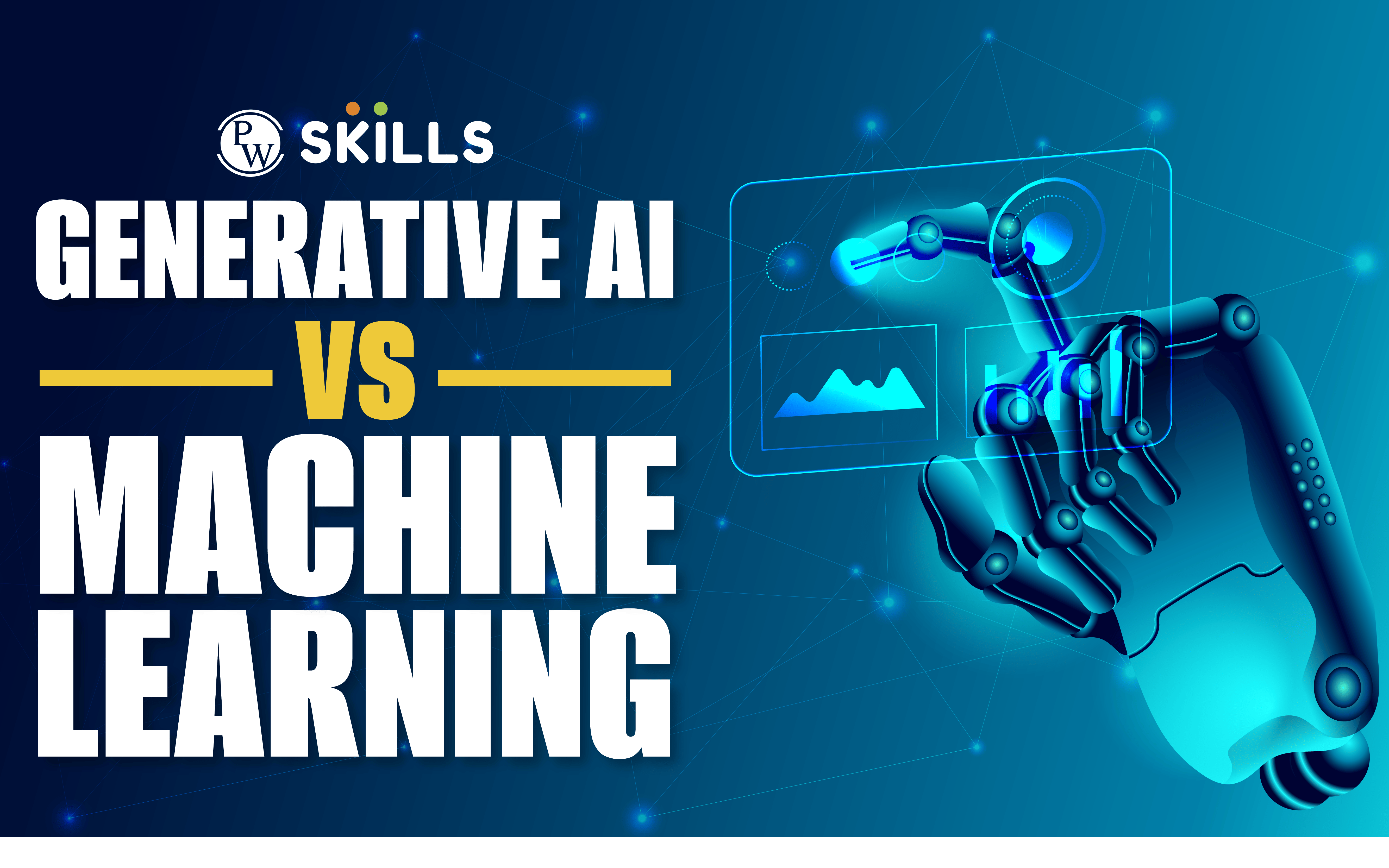Generative AI vs Machine Learning: Are you overwhelmed by the magnitude of technical jargon surrounding today’s AI solutions? Between generative AI, machine learning, and other complex terms, it can seem impossible to understand which solution will best fit your needs.
That’s why we are here! In this blog post, let’s take a deep dive into Generative Artificial Intelligence (AI) vs. Machine Learning – what they are exactly and how they differ from one another – so you can feel informed and empowered when making decisions about your technology investments.
We understand that these innovative fields of technology might sometimes appear daunting; but trust us when we say that with our friendly approach to breaking down key concepts in simple language, you’ll soon get an important overview of each field along with guidance on choosing the right solution for you or your business.
To facilitate the adoption and understanding process, the first step for anyone interested in learning about this intersection is a course such as Master Generative AI: Data Science by Physics Wallah, and we offer a special Reader coupon which offers an amazing discount.
What is Generative AI?

Generative AI represents an emerging technology that employs artificial intelligence, sophisticated algorithms, and large language models to create content. On the other hand, machine learning utilizes deep learning and neural network techniques to generate content based on observed patterns in a diverse range of existing content.
Despite being labeled as original, generative AI utilizes machine learning and AI models to analyze and replicate the past creativity of others. It delves into extensive content repositories, leveraging the information to emulate human creativity.
The capabilities of generative AI extend beyond conventional machine learning. By harnessing various forms of machine learning systems, models, algorithms, and neural networks, generative AI opens up a novel dimension in the realm of creativity.
For instance, it can analyze the entire literary works of authors like Charles Dickens, J.K. Rowling, or Ernest Hemingway and produce an original novel that aims to emulate these authors’ distinct styles and writing patterns.
Also read: Top 10 Generative AI Startups in the World
What is Machine Learning?
Machine learning operates as a subset of artificial intelligence, utilizing algorithms to scrutinize data, learn from it, and formulate predictions and informed decisions. Rather than requiring explicit programming for every behavioral rule, machine learning algorithms are crafted to learn and enhance their performance through experience autonomously.
These models learn by scrutinizing training data, employing statistical techniques to discern patterns, extract insights, and uncover relationships between inputs and outputs. As the algorithms encounter new data, they continually update and refine their ability to generate accurate predictions and analyses.
In essence, machine learning facilitates computers in problem-solving through processes that emulate the natural learning mechanisms of humans. Using extensive datasets in ML algorithms would be an exceedingly complex task if attempted through manual programming.
Also read: Quantum Machine Learning: Uses, Applications, Examples
Generative AI vs. Machine Learning: Key Differences B/W Generative AI and Machine Learning
Here are the key differences between generative AI and machine learning:
| Generative AI vs. Machine Learning: Key Differences B/W Generative AI and Machine Learning | ||
| Criteria | Generative AI | Machine Learning |
| Objective | Creates new data instances, generates content | General approach to learning patterns from data |
| Learning Type | Based on Generative Models like GANs, VAEs | Supervised, Unsupervised, Reinforcement Learning |
| Customization | Highly customizable for various creative applications | Customizable based on task requirements and choice of algorithms |
| Training Data | Requires diverse training data for creative output | Trained on specific datasets for defined tasks |
| Training Time | May require extensive training time for creative tasks | Training time depends on dataset size and complexity of the model |
| Use Cases | Creative tasks, content generation, artistic applications | Predictive modeling, classification, pattern recognition |
| Output | Generates new, original data instances | Predicts or classifies based on learned patterns |
| Example Applications | DALL-E for image generation, ChatGPT for text generation | Image classification, Speech recognition, Recommendation systems |
| Complexity | High complexity due to creative nature and diversity of outputs | Varies based on the specific machine learning algorithm used |
| Interpretability | Often lacks clear interpretability due to creative outputs | Models may offer interpretability based on the algorithm used |
| Resource Intensity | Demands significant computational resources for training | Resource requirements vary based on the ML algorithm and dataset |
Generative AI vs. Machine Learning Examples
Here are some of the Generative AI vs Traditional AI examples:
| Generative AI vs. Machine Learning Examples | ||
| Application | Generative AI Examples | Machine Learning Examples |
| Image Generation | DALL-E by OpenAI, DeepArt.io | Image Classification, Object Detection |
| Music Composition | Google’s Magenta, AIVA | Recommendation Systems, Predictive Analytics |
| Artistic Style Transfer | Neural Style Transfer algorithms | StyleGAN for Image Synthesis |
| Game Content Generation | Procedural Content Generation in games | Reinforcement Learning for Game AI |
| Video Synthesis | Deepfake technology using GANs | Video Classification, Video Analysis |
| Voice Generation | Lyrebird, Descript | Speech Recognition, Voice Biometrics |
| Text Generation | GPT-3 by OpenAI, ChatGPT | Natural Language Processing (NLP), Sentiment Analysis |
Also read: Artificial Intelligence and Machine Learning: How Do They Differ?
Generative AI vs Machine Learning vs Deep Learning
Below is a table outlining the distinctions between Generative AI, Machine Learning, and Deep Learning:
| Generative AI vs Machine Learning vs Deep Learning | |||
| Feature | Generative AI | Machine Learning | Deep Learning |
| Definition | Utilizes AI, algorithms, and large language models to generate content based on patterns observed in existing content. | A subset of AI that employs algorithms to analyze data, learn from it, and make predictions based on the learned patterns. | A subset of machine learning that involves neural networks with multiple layers (deep neural networks) to learn and make decisions. |
| Scope of Learning | Mimics human creativity by analyzing and replicating patterns from extensive repositories of content. | Learns from data and experience to make predictions, recognize patterns, and inform decisions. | Involves hierarchical learning with multiple layers of neural networks learning hierarchical features from data. |
| Applications | Content generation, creative tasks, style imitation, and artistic pursuits. | Predictive analytics, recommendation systems, image and speech recognition, and natural language processing. | Image and speech recognition, language translation, autonomous vehicles, and advanced pattern recognition. |
| Training Data | Relies on large datasets for understanding patterns and generating creative outputs. | Trains on labeled datasets to learn patterns, correlations, and features. | Requires massive datasets for learning hierarchical representations of data. |
| Complexity | Offers advanced capabilities in creative tasks but may not always adhere to real-world logic. | Adaptable and widely used for a variety of tasks, balancing simplicity and effectiveness. | Handles complex tasks by automatically learning hierarchical features, but may require substantial computational resources. |
| Common Algorithms | GPT (Generative Pre-trained Transformer) models, VAEs (Variational Autoencoders). | Decision trees, support vector machines, k-nearest neighbors, neural networks. | Convolutional Neural Networks (CNNs), Recurrent Neural Networks (RNNs), Transformers. |
| Training Process | Trained on diverse datasets to understand different styles and patterns. | Trained iteratively with labeled datasets to optimize predictive accuracy. | Involves deep neural networks trained layer by layer using backpropagation and optimization techniques. |
| Use Cases | Content creation, style transfer, text generation, art synthesis. | Predictive analytics, recommendation systems, fraud detection, language translation. | Image and speech recognition, natural language processing, autonomous vehicles, healthcare diagnostics. |
If you’re looking for ways to get started with Generative AI, Master Generative AI: Data Science by Physics Wallah is the best course that will provide everything from basic theory introduction through advanced understanding. You can also use coupon “READER” during checkout for a 10% discount – what are you waiting for? Let’s move one step closer towards building the future of AI!
Also read: 15 Best Generative AI Tools To Check Out In 2024!
FAQs
What is the primary difference between Generative AI and Machine Learning?
Generative AI and Machine Learning (ML) are related concepts but differ in their core functionality. While Machine Learning encompasses a broader set of algorithms and techniques for making predictions or classifications based on data, Generative AI specifically focuses on creating new data, such as images, text, or even music.
How does Generative AI create new data, and what role does it play in Machine Learning?
Generative AI employs models trained on large datasets to generate new content autonomously. In Machine Learning, Generative AI adds a creative dimension by producing original data rather than predicting or classifying existing data.
What are some common applications of Generative AI?
Generative AI finds applications in diverse fields. It is used for image and video synthesis, text generation, realistic deepfakes, and artistic endeavors like generating paintings or music. Generative AI introduces creativity and imagination into the machine-learning landscape.
Can you provide an example of a Generative AI model?
One notable example is OpenAI's GPT (Generative Pre-trained Transformer) model series, such as GPT-3. These models are designed to generate human-like text based on the input they receive, showcasing the capability to create contextually relevant and coherent content.
Is Generative AI the same as Machine Learning?
No, Generative AI and Machine Learning (ML) are related concepts but not synonymous. Machine Learning is a broader field encompassing various techniques where systems learn patterns from data to make predictions or decisions. Generative AI, on the other hand, is a subset of AI that specifically focuses on creating new, original content autonomously, such as images, text, or music.




